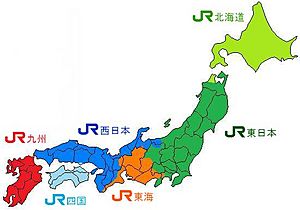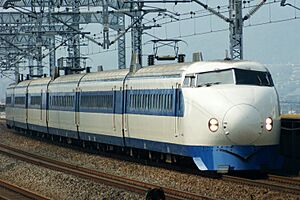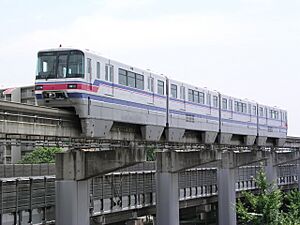Japanese railways facts for kids
Japanese railways are a super important way to travel in Japan! They help lots of people get around, whether it's for fast trips between big cities or daily commutes in busy areas.
Who Runs Japan's Trains?
In Japan, trains are run by two main types of companies:
- Japan Railways Group (or JR for short): This is a big group of seven different companies. Each company handles trains in a specific part of Japan, like Hokkaidō, Higashi-Nihon, Tokai, Nishi-Nihon, Shikoku, Kyūshū, and even a company just for freight trains!
- Private Railways (called Shitetsu in Japanese): These are other train companies that are not part of the JR Group. They often run local lines or connect specific cities. Some private railways are even run by local governments, like the ones in Tokyo.
Different Types of Japanese Trains
Japanese trains come in many shapes and sizes, designed for different speeds and routes:
- Shinkansen (新幹線): These are Japan's famous "bullet trains"! The word means "New main line." They run on special tracks that are wider than normal (1,435mm) and can go super fast, up to 300 kilometers per hour (about 186 miles per hour)!
- Zairaisen (在来線): This means "Older railway line." These are the regular trains that run on tracks that are usually a bit narrower (1,067mm) and go at slower speeds than the Shinkansen. You'll find many different types of trains on these lines:
- Subway (地下鉄): These trains run underground, mostly in big cities, to help people get around quickly.
- Tram (路面電車): These are like small trains that run on tracks right on the street, often in cities.
- Monorail (モノレール): These are unique trains that run on a single, elevated beam or rail.
- Trolley bus (トロリーバス): These are like buses that get their power from overhead electric lines.
- Funicular (ケーブルカー): These are special cable cars that pull passengers up and down steep hills.
- And other special types of trains!
A Quick Look at Japanese Train History
Japanese railways have a long and interesting history:
- 1872: The very first train in Japan started running on October 14th, connecting the cities of Shinbashi and Yokohama.
- 1877: A new train line opened between Kyoto and Osaka.
- 1880: The Temiya-Sapporo line began operating.
- 1889: The important Tōkaidō line was finished, connecting Shinbashi all the way to Kobe.
- 1927: Japan's first subway line opened in Tokyo, running between Ueno and Asakusa.
- 1964: A huge milestone! The first Shinkansen "bullet train" line opened, just in time for the Tokyo Olympics.
- 1975: The Tōkaidō-San'yō Shinkansen line was completed, extending the high-speed network.
- 1976: All steam locomotives (old-fashioned trains powered by steam) were retired from regular service.
- 1982: New Shinkansen lines, the Tōhoku and Joetsu Shinkansen, opened.
- 1987: The Japan National Railway company was split up, and the new JR Group companies were created.

All content from Kiddle encyclopedia articles (including the article images and facts) can be freely used under Attribution-ShareAlike license, unless stated otherwise. Cite this article:
Japanese railways Facts for Kids. Kiddle Encyclopedia.




